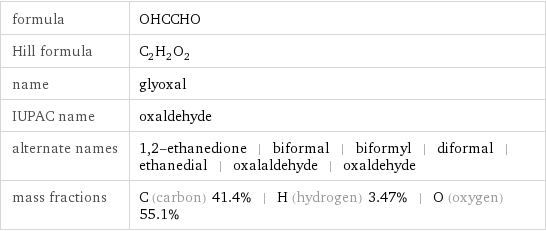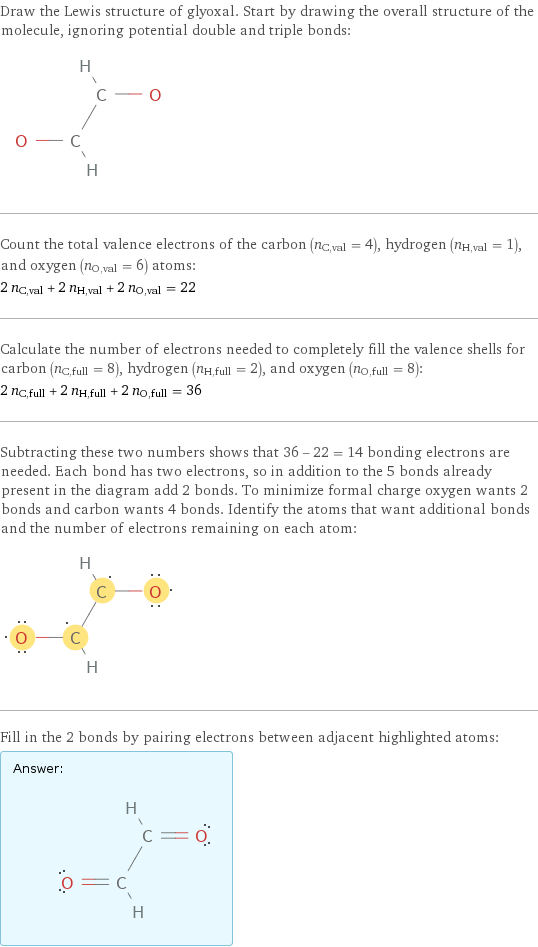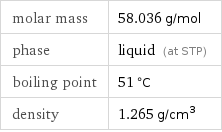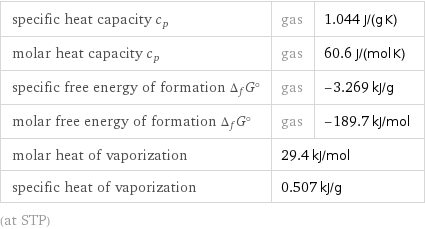Input interpretation

glyoxal
Chemical names and formulas

formula | OHCCHO Hill formula | C_2H_2O_2 name | glyoxal IUPAC name | oxaldehyde alternate names | 1, 2-ethanedione | biformal | biformyl | diformal | ethanedial | oxalaldehyde | oxaldehyde mass fractions | C (carbon) 41.4% | H (hydrogen) 3.47% | O (oxygen) 55.1%
Lewis structure

Draw the Lewis structure of glyoxal. Start by drawing the overall structure of the molecule, ignoring potential double and triple bonds: Count the total valence electrons of the carbon (n_C, val = 4), hydrogen (n_H, val = 1), and oxygen (n_O, val = 6) atoms: 2 n_C, val + 2 n_H, val + 2 n_O, val = 22 Calculate the number of electrons needed to completely fill the valence shells for carbon (n_C, full = 8), hydrogen (n_H, full = 2), and oxygen (n_O, full = 8): 2 n_C, full + 2 n_H, full + 2 n_O, full = 36 Subtracting these two numbers shows that 36 - 22 = 14 bonding electrons are needed. Each bond has two electrons, so in addition to the 5 bonds already present in the diagram add 2 bonds. To minimize formal charge oxygen wants 2 bonds and carbon wants 4 bonds. Identify the atoms that want additional bonds and the number of electrons remaining on each atom: Fill in the 2 bonds by pairing electrons between adjacent highlighted atoms: Answer: | |
3D structure

3D structure
Basic properties

molar mass | 58.036 g/mol phase | liquid (at STP) boiling point | 51 °C density | 1.265 g/cm^3
Units

Liquid properties (at STP)

density | 1.265 g/cm^3 vapor pressure | 18 mmHg refractive index | 1.409
Units

Thermodynamic properties

specific heat capacity c_p | gas | 1.044 J/(g K) molar heat capacity c_p | gas | 60.6 J/(mol K) specific free energy of formation Δ_fG° | gas | -3.269 kJ/g molar free energy of formation Δ_fG° | gas | -189.7 kJ/mol molar heat of vaporization | 29.4 kJ/mol | specific heat of vaporization | 0.507 kJ/g | (at STP)
Chemical identifiers

CAS number | 107-22-2 Beilstein number | 1732463 PubChem CID number | 7860 PubChem SID number | 24847859 SMILES identifier | C(=O)C=O InChI identifier | InChI=1/C2H2O2/c3-1-2-4/h1-2H RTECS number | MD2700000 MDL number | MFCD00006957
NFPA label

NFPA label

NFPA health rating | 1 NFPA fire rating | 0 NFPA reactivity rating | 0
Safety properties

flash point | -4 °C autoignition point | 285 °C
Toxicity properties

RTECS classes | primary irritant